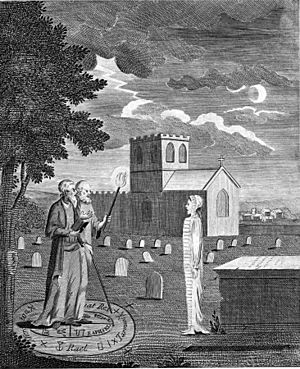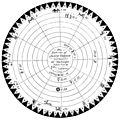Ebenezer Sibly facts for kids
Ebenezer Sibly (born in 1751, died around 1799) was an English doctor, astrologer, and writer who studied mysterious topics.
Contents
About His Life
Ebenezer Sibly was born in London, in an area called Cripplegate. His parents were Edmund Sibly and Mary Larkholm. He also had a brother named Manoah Sibly. From a young age, Ebenezer was very interested in medicine and astrology. He studied surgery in London.
In 1785, he was working as an astrologer in Bristol. By 1788, he had moved back to London. In 1789, he became a leader in a group called the Lodge of Joppa #188, which was one of the first masonic lodges under the Ancient Grand Lodge of England. In 1790, he spent some time in Ipswich, helping a politician named Sir John Hadley D'Oyly during an election. On April 20, 1792, he earned his M.D. degree (which means Doctor of Medicine) from King's College, Aberdeen.
While studying medicine, Sibly became curious about ideas like "animal magnetism" from Anton Mesmer. He joined Mesmer's "Harmonic Philosophical School." He also became interested in theosophy, which involves spiritual ideas and the search for wisdom.
Ebenezer Sibly passed away in London around 1799.
His Writings
Sibly is well-known for creating a special horoscope for the United States of America. He published this in 1787, and people still talk about it today.
Translations and Sources
Ebenezer Sibly used many different old and mysterious writings for his work. His brother, Manoah Sibly, was good with languages and also a preacher. Manoah helped with translating some texts, including a new version of Tetrabiblos and a work by Placidus de Titis. As an astrologer, Ebenezer used a system called the Placidian system for his horoscopes. He also translated a text about alchemy by Bernard Trevisan.
The Complete Illustration
One of Sibly's most famous works was New and Complete Illustration of the Celestial Science of Astrology. He published this in four books starting in 1784. This large work included details about magical practices and descriptions of the spirit world. These ideas came from an older book called Discoverie of Witchcraft by Reginald Scot. Later versions of Sibly's book were published after he died, with titles like Astrology, A New and Complete Illustration of the Occult Sciences (1806) and The New and Complete Illustration of the Celestial Science of Astrology (1817).
Other Books
In 1792, Sibly also published a book called A Key to Physic, and the Occult Sciences.
He also helped create an illustrated version of Culpeper's English Physician and Complete Herbal in 1790. The original book by Nicholas Culpeper was published in 1652 without pictures, but Sibly added drawings to the later edition.
Images for kids







